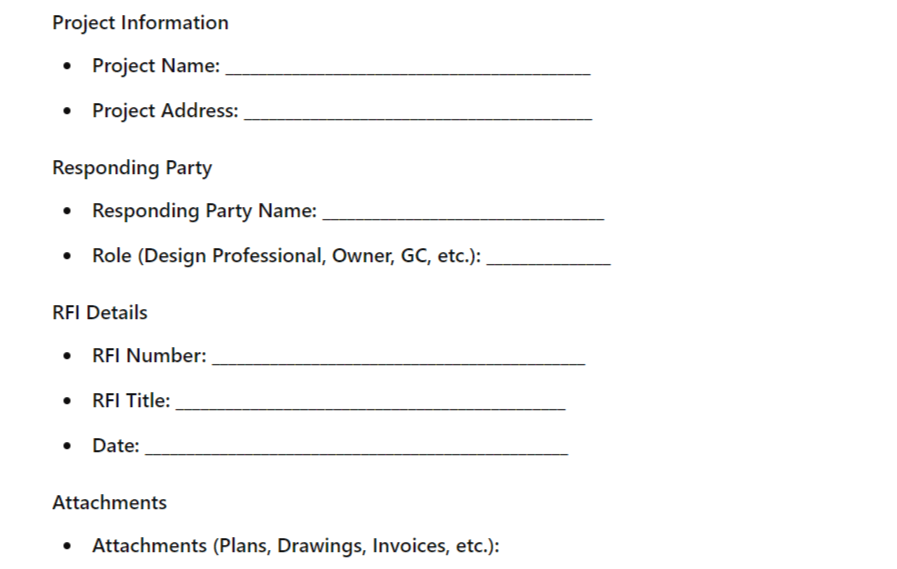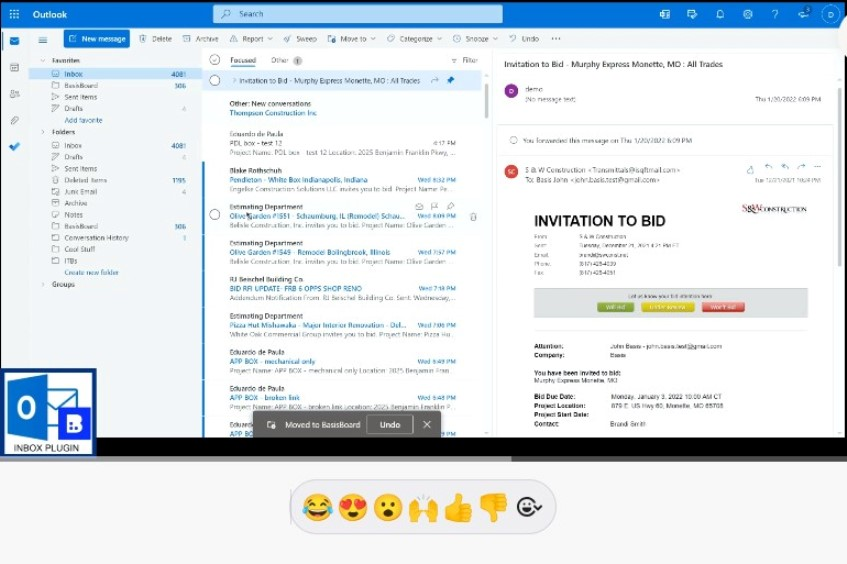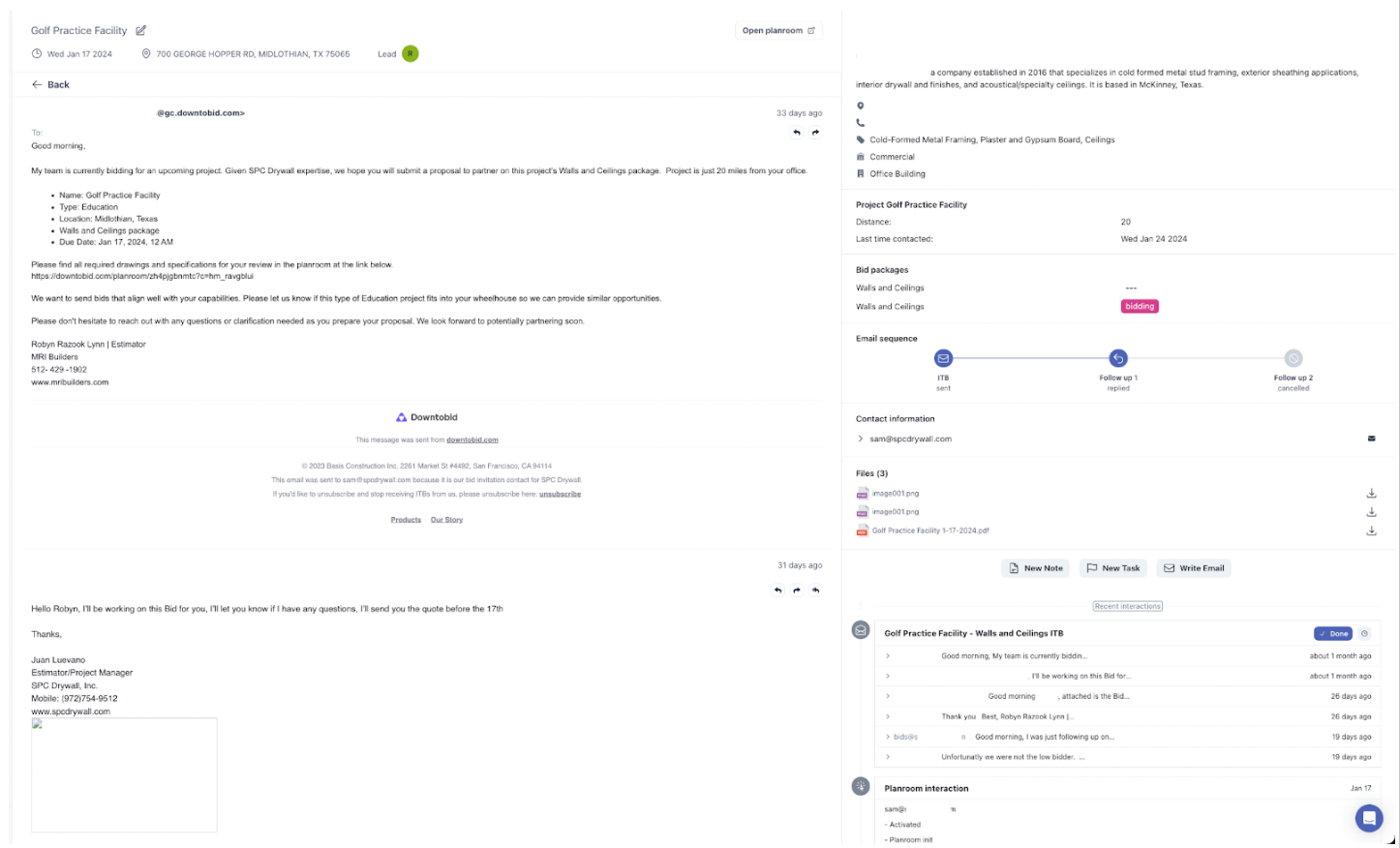The golden rule in construction: if it's not written down, it doesn't exist. Verbal agreements have their place, but when it comes to keeping projects on track and disputes at bay, you need something more concrete — literally.
Construction RFIs are your go-to tool for maintaining clarity and ensuring everyone is on the same page. They provide a direct line to project managers, owners, and other contractors when you:
- need answers
- want to clarify doubts
- want to prevent costly misunderstandings that can turn a project into a nightmare.
In this article, we'll explore when and how to use RFIs effectively and provide a downloadable RFI template to streamline your project management process.
Note: If you're looking to easily send personalized invites to relevant subcontractors in minutes, consider trying Downtobid. Our software uses AI to break down project plans — ensuring 100% scope coverage — and automatically sends out bid invites with subcontractor names and relevant project information. Experience the efficiency firsthand — try our software free today.
Key Takeaways
- Construction RFIs seek project clarification, create paper trails, prevent costly misunderstandings.
- Template includes project details, contacts, inquiry description, documents, response space, deadlines.
- RFI differs from RFP (proposals), RFQ (quotations), RFT (tenders) in purpose and scope.
- Provides standardized format, easy editing, trackable communication features.
- Downtobid centralizes RFI management, automates bid creation, reduces preparation time 30%.
RFIs in a Nutshell
In an ideal world, every single detail of a building's design and construction would be crystal clear from the start. But in reality, gray areas always need clarifying as the project unfolds.
An RFI can help resolve such uncertainties. It is a formal document used throughout the construction process to seek clarification on specific aspects of a project. Think of it as a structured way to ask questions and document the answers, creating a clear paper trail that ensures everyone stays on the same page.
Anyone can send an RFI to anyone else involved in the project, whether it's:
- a contractor coordinating multiple moving parts
- an architect ensuring their vision is correctly implemented
- a client wanting to stay in the loop
- government authorities needing details for regulatory compliance.
While any project stakeholder can issue an RFI, contractors typically lead, with clients responding to these requests. They’re often sent in the early stages of a project — during pre-construction, the project bidding process, or the procurement process — when everyone's still trying to get their bearings.
General contractors can also use RFI templates to ask broader questions about subcontractors and their capabilities. This process acts as an initial screening, helping to narrow down a wide pool of potential subcontractors to a select few that meet the project’s specific needs.
Functions of Construction RFIs
RFIs serve several essential functions in the construction industry. They allow you to:
- seek detailed design specifics from contractors when plans are unclear or conflicting.
- adjust project timelines based on resource availability and scheduling constraints.
- request crucial information about project work and materials from the project manager or owner.
- propose alternative materials that meet project needs when specified ones are unavailable, unaffordable, or unsuitable.
- resolve site conditions, sequencing problems, or conflicting information among project stakeholders.
What’s Included in Our RFI Template
When we created our RFI template, we wanted to make sure it covered all the bases. That’s why we made sure our template:
- Is easily editable: You can tailor it to fit the unique requirements of each project while keeping a consistent framework.
- Follows a standardized format: This ensures recipients can quickly understand and respond right in the same document, making the whole process smoother.
- Has trackable features: These help you easily keep tabs on all your communications with contractors, maintaining a clear record of every exchange.

Here are some key details that our template includes:
- Name, address, and any other identifying information to contextualize the RFI.
- Your company name and contact information.
- The recipient’s company name and contact information.
- An RFI number, starting at zero for the project and increasing with each subsequent request.
- A title and brief description that quickly conveys the purpose of the RFI.
- Detailed description of the inquiry.
- Description of any attached documents for additional context or reference.
- Space for the recipient to address the concern.
- Submission and response deadlines to ensure timely responses and keep projects on schedule.
You can download the template here.
Alongside the RFI template, we’ve created an RFI log to keep things even more organized. This log allows you to track all incoming RFIs, each tagged with a unique number and a due date for responses. You can download it here.

A quick note before using our RFI template: You want to set clear ground rules and ensure each party understands them before you start exchanging RFIs. Your construction contract should spell out when to submit them, what format to use, evaluation criteria, and the timeframe for responding. It keeps things fair and prevents headaches later.
RFI, RFP, RFQ, and RFT: What’s the Difference?
You might have heard about various types of requests like RFI, RFP, RFQ, and RFT. Each plays a critical role throughout the project lifecycle, and understanding them is key to managing your construction projects effectively. We’ve covered the 3 other requests in our previous guides, but here’s a quick summary of how they differ from an RFI document:
Request for Proposal (RFP)
When you issue a Request for Proposal, you’re asking for in-depth project information from potential contractors. This could include methods, timelines, and specific pricing details. Essentially, you want to understand how a contractor plans to execute the project and at what cost.
This differs from the RFI, where you're not making any commitments or asking for prices - you're simply seeking clarity.
Request for Quotation (RFQ)
Before you even get to the bidding process, you want to make sure potential contractors are up to the task. A Request for Quotation is an essential tool that handles this by asking for information on their financial stability, safety records, and other qualifications. In response, contractors usually provide a Statement of Qualifications, which outlines their experience, capabilities, credentials, and any other requested information.
Request for Tender (RFT)
When you issue an RFT, you’re looking to generate a legally binding contract with clear job terms once it’s accepted. The RFT process involves detailed job specifications and requirements, and the result is a formal contract that sets out the terms of the project.
Unlike RFIs, which are primarily about seeking clarification, RFTs are about formalizing agreements and setting terms for project execution.
How Downtobid Makes Creating and Sending RFIs Much Easier
Traditionally, documenting and tracking RFIs has been a tedious and time-consuming process. You create an RFI, log it in your spreadsheet, send it via email, and then... you wait.
It’s no wonder the first reply to an RFI can take almost a week on average across projects globally. Every day an RFI sits unanswered is a day your project stalls — and these delays can quickly snowball.
While our RFI template can give you some relief, it doesn’t fix the root problem of inefficiency in document management. What you really need is a centralized platform that allows you to create and send documents effortlessly, including RFIs, RFPs, RFQs and more.
Downtobid offers a centralized system, consolidating everything you need in one place. It handles everything electronically within the same platform, simplifying tracking bid documents and paperwork. Better yet, everyone on your team can access, review, and update files in real-time.
And this means:
- You’re no longer waiting days for an email response or hunting down the right person for an answer.
- You don't need to dig through countless folders to locate one document
- No more juggling between text documents, spreadsheets, and endless email chains.
This translates to fewer delays, fewer misunderstandings, and a smoother path to project completion.

But our platform offers more than just a bid board. Downtobid streamlines the entire pre-construction process from start to finish, making every step —from initial inquiry to final contract— a smoother, more efficient process.
Simplify the Entire Preconstruction Process with Downtobid
Downtobid allows you to turn your plans and specifications into bid invites and scope sheets in minutes. Just upload your documents, and our platform does the rest. Here’s what you’ll get after uploading your construction plans:
- Descriptive summaries for each bid package
- Instances of detected scopes within your plans
- A list of recommended subcontractors
But that's not all; Downtobid goes a step further by creating personalized bid invites. These aren’t your run-of-the-mill, generic invitations. They're ITBs that can help build a connection with potential subs from the outset by including:
- the contractor's name, making them feel valued from the get-go.
- specifics like square footage and project type right in the email subject. No more vague "Bid Invite" emails getting lost in crowded inboxes.
- relevant details upfront, so that contractors can quickly assess if the project is a good fit, saving time for everyone involved.

Our users have already started seeing impressive results:
- Bid preparation time cut by up to 30%.
- Quicker project turnaround and significant cost savings.
- Less time wrestling with paperwork, meaning more time focusing on what they do best – building great construction projects.
You can start experiencing these benefits today. Upload your construction plans for free and see firsthand how Downtobid can transform your preconstruction process.